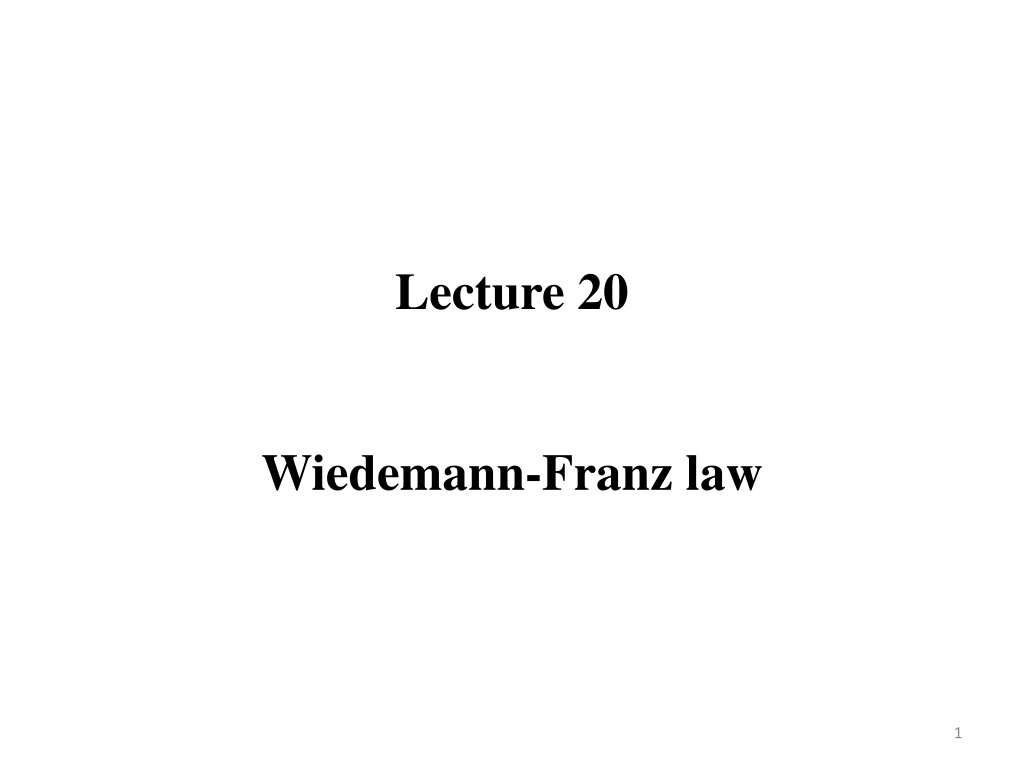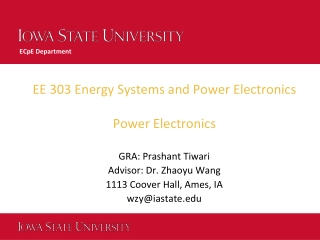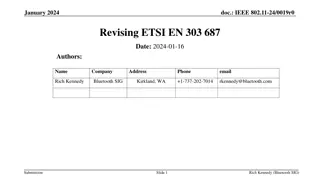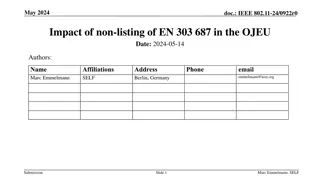
Understanding Wiedemann-Franz Law and Thermal Conductivity in Materials
Explore the relationship between thermal and electrical conductivity in materials governed by the Wiedemann-Franz law. Learn how heat is transmitted in solids, gases, and metals based on their unique properties and modes of heat transfer.
Uploaded on | 27 Views
Download Presentation

Please find below an Image/Link to download the presentation.
The content on the website is provided AS IS for your information and personal use only. It may not be sold, licensed, or shared on other websites without obtaining consent from the author. Download presentation by click this link. If you encounter any issues during the download, it is possible that the publisher has removed the file from their server.
E N D
Presentation Transcript
Lecture 20 Wiedemann-Franz law 1
Recap Thermal conductivity is defined as the quantity of heat (Q) transmitted through a unit thickness (d) in a direction normal to a surface of unit area (A) due to a unit temperature gradient ( T) under steady state conditions and when the heat transfer is dependent only on the temperature gradient. Gases have lower relative thermal conductivities, as their molecules are not as tightly packed as those in solids. In contrast, in non metallic solids thermal conductivity primarily occurs through vibrations in the lattices. hence have the higher thermal conductivities. Metals have the highest thermal conductivities of any materials and have the unique combination of possessing both thermal and electrical conductivity. The free electrons of the metals can freely move throughout the solid and transfer the thermal energy at a rate very high as compared to insulators. It is due to this that the metals posses high thermal conductivity 2
Mode of heat transfer In insulators or for non-metallic solids heat is carried entirely by Phonons. It means the heat transfer is view as being transferred by lattice vibrations, as atoms vibrating more energetically at one part of a solid transfer that energy to less energetic neighboring atoms. This can be enhanced by cooperative motion in the form of propagating lattice waves, which in quantum limits are quantized as Phonons. But in metals heat may be transported by both electrons and phonons. So the total conductivity is KT = Kphonon + Kelectron; since the transfer of heat in solids owing to phonon and electron.In most metals contribution of electron is greater phonon typically by Kp = 10-2 Ke . Hence Kp is usually neglected. 3
Wiedemann-Franz law Wiedemann-Franz law is the law which relates the thermal conductivity ( ) and the electrical conductivity ( ) of a material which consists of somewhat freely moving electrons in it. Thermal Conductivity ( ): It is the degree (measure) of capacity of a material to conduct heat. Electrical Conductivity ( ): It is the degree (measure) of capacity of a material to conduct electricity. 4
Wiedemann-Franz law In metals; when temperature increases, the velocity of free electrons increases and that leads to an increase in heat transfer and it also increases the collisions between the lattice ions and free electrons. This results in the drop in electrical conductivity. The law defines the ratio of the electronic role of the thermal conductivity of a material to the electrical conductivity of a material (metal) is directly relative to the temperature. K Coefficient of thermal conductivity (W/mK) K = Kphonon + Kelectron; since the transfer of heat in solids owing to phonon and electron. 5
Wiedemann-Franz law Now, we can derive the expression for coefficient of thermal conductivity. For that, we have to assume the flow of heat is from higher temperature to lower temperature in a metal slab which has a temperature gradient of ( dT/dx). cv Specific heat n Number of particles per unit volume mean free path of collisions v velocity of electrons 6
Wiedemann-Franz law Comparing the equations (1) and (2), we get We know that the energy of free electrons is 7
Wiedemann-Franz law We put the equation (4) in (3) The electrical current density of a metal with the application of electric field, E J = E ; Ohms law----------------(7) 8
Wiedemann-Franz law Electrical Conductivity is given by : So, the correct form of Ohms law is given by There is a mean free path and mean time between the collisions. 9
Wiedemann-Franz law e Charge of the electron = 1.602 10-9 C Collision time or mean time: It is the average time for the electron to move or travel prior to scattering. vd Drift Velocity: It is the standard velocity of the electron during the collision time. When we put equation (8) in (7), we get electrical conductivity (Drude Conductivity) as Consider the electrons which move in a metal without any application of electrical field. Then the equipartition theorem is given by 10
Wiedemann-Franz law From equation (10) we get m as Now, we put equation (11) in (9) Thus, we got the values of K and from equation (6) and (12). Now, we can take the ratio 11
Wiedemann-Franz law We assume v = vd, then equation (13) becomes 12
Limitations of Wiedemann Franz Law From this, we can say that the ratio is similar for all the metals. It is also a function of temperature. This law is known as Wiedemann-Franz Lorenz Law. We can conclude that the most excellent electrical conductor will be a best thermal conductor. The value of L is not the same for all the materials. This law is not valid for intermediate temperature. In the pure metals, both and increases as temperature decreases 13






















